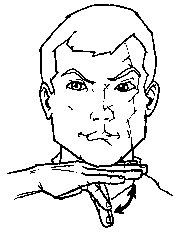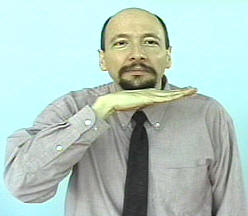The sign for "pig" is made by placing a flat hand under your chin, palm down. With your fingers pointing to the left,
(if you are right handed) bend and unbend your hand several
times from the knuckles. Your wrist should not move. The fingers do not "wiggle." They bend and unbend from the large
knuckles. If you "wiggle or flutter" the fingers (instead of bending
and unbending at the large knuckles) it changes the meaning to "dirty."
PIG:





Optional Reading, not needed for
class:
In a message dated 9/28/2003 9:53:41 AM Pacific Daylight Time, nyccavy@msn.com
writes:
<<If you can and for my own person curiosity, how under the sun do you sign
"guinea pig"?? No one can tell me!>>
Technically I reckon you should spell "g-u-i-n-e-a" and then sign PIG.
If I had a magic wand I'd zap myself to "New Guinea" and find out the sign
for that country from the local native Deaf. Then I'd use that sign combined with
their sign for pig.
But, lacking such a magic wand, just between you and me what would I do? I'd sign "TEST
PIG" if I were talking about
the idea of someone or something being used as a test or prototype. If I
were talking about the actual animal, after spelling it out the first time I might
use the sign for "swollen cheeks" and then pig. Swollen cheeks would be
signed with "claw" hands on each cheek. Of course, "no one" beyond that
immediate conversation would have any clue what I was talking about, but it
would work well during that particular conversation. Also if I were not
discussing any type of pigs other than guinea pigs, after I indicated
"guinea" the first time or two, I'd just drop it and only sign "pig." The
other person would still understand that I was talking about the cute
little furry ones and not the big mud covered ones.
- Dr. Bill